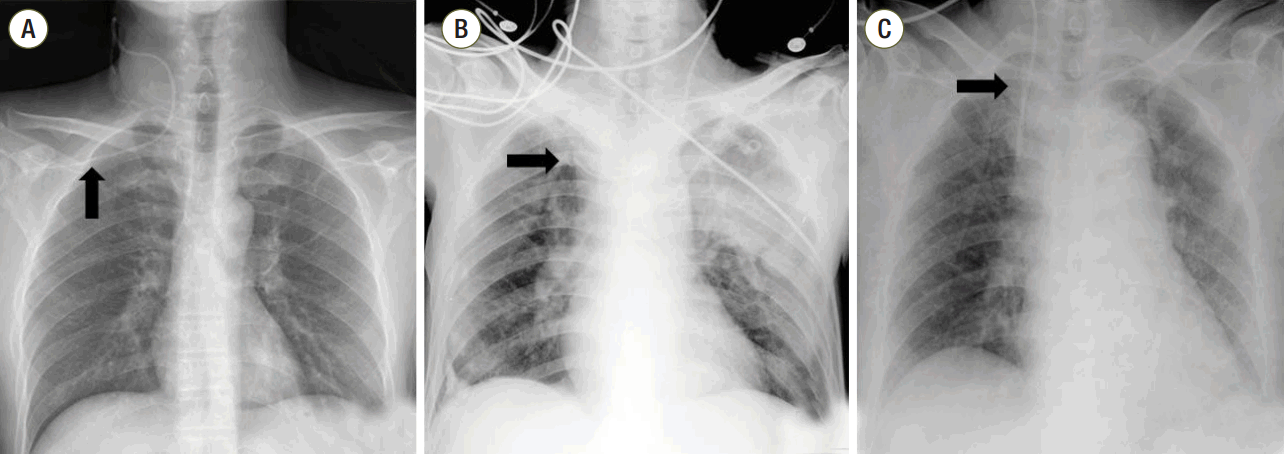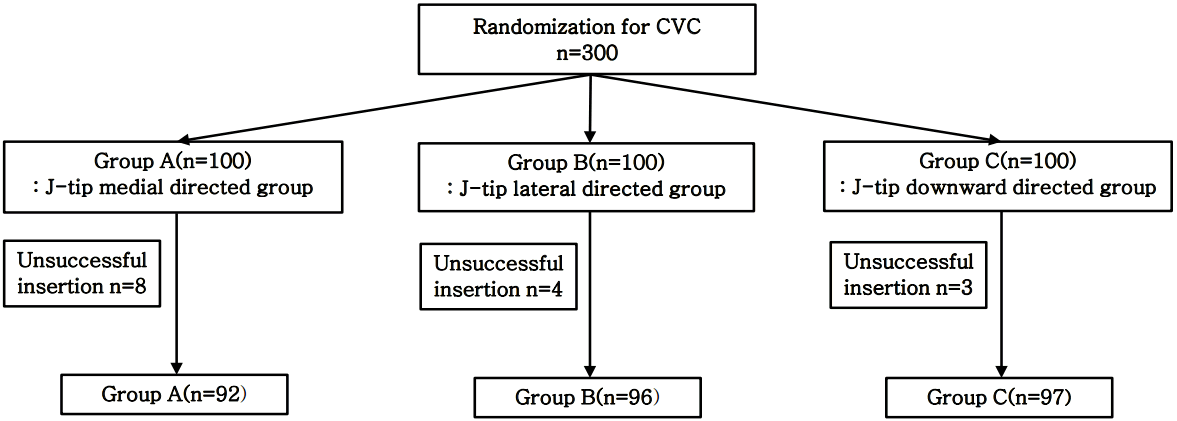1. Miller AH, Roth BA, Mills TJ, Woody JR, Longmor CE, Foster B. Ultrasound guidance versus landmark technique for the placement of central venous catheters in the emergency department. Acad Emeg Med. 2002; 9:800–5.
2. Ruesch S, Walder B, Tramèr MR. Complications of central venous catheters: internal jugular versus subclavian access--a systematic review. Crit Care Med. 2002; 30:454–60.

3. Boardman P, Hughes JP. Radiological evaluation and management of malfunctioning central venous catheters. Clin Radiol. 1998; 53:10–6.
4. Oh AY, Jeon YT, Choi EJ, Ryu JH, Hang JW, Park HP, et al. The influence of the direction of J-tip on placement of a subclavian catheter: real time ultrasound-guided cannulation versus landmark method, a randomized controlled trial. BMC Anesthesiology. 2014; 14:11.

5. Sanchez R, Halck S, Walther-Lasen S, Heslet L. Misplacement of subclavian venous catheters: importance of head position and choice of puncture site. Br J Anaesth. 1990; 64:632–3.

6. Kang M, Ryu HG, Son IS, Bahk JH. Influence of shoulder position on central venous catheter tip location during infraclavicular subclavian approach. Br J Anaesth. 2011; 106:344–7.

7. Tripathi M, Dubey PK, Ambesh SP. Direction of the J-tip of the guidewire, in seldinger technique, is a significant factor in misplacement of subclavian vein catheter: a randomized, controlled study. Anesth Analg. 2005; 100:21–4.

8. Ahn H, Kim G, Cho B, Jeong W, Yoo Y, Ryu S, et al. How to decrease the malposition rate of central venous catheterization: real-time ultrasound-guided reposition. Korean J Crit Care Med. 2013; 28:280–6.

9. Leung J, Duffy M, Finckh A. Real-time ultrasonographically-guided internal jugular vein catheterization in the emergency department increases success rates and reduces complications: a randomized, prospective study. Ann Emerg Med. 2006; 48:540–7.

10. Felleiter P, Gustorff B, Lierz P, Hӧrauf K. Use of electrocardiographic placement control of central venous catheters in Austria. Acta Med Austriaca. 1999; 26:109–13.
11. Wang HE, Sweeney TA. Subclavian central venous catheterization complicated by guidewire looping and entrapment. J Emerg Med. 1999; 17:721–4.

12. Maffessanti M, Bortolotto P, Kette F. Malpositions and complications following central venous catheterization in relation to the access site. Radiol Med. 1988; 75:609–12.
13. Muhm M, Sunder-Plassmann G, Apsner R, Pernerstorfer T, Rajek A, Lassingg A, et al. Malposition of central venous catheters. Incidence, management and preventive practices. Wien Klin Wochenschr. 1997; 109:400–5.
14. Bagwell CE, Salzberg AM, Sonnino RE, Haynes JH. Potentially lethal complications of central venous catheter placement. J Pediatr Surg. 2000; 35:709–13.

15. McGee WT, Ackerman BL, Rouben LR, Prasad VM, Bandi V, Mallory DL. Accurate placement of central venous catheters: a prospective, randomized, multicenter trial. Crit Care Med. 1993; 21:1118–23.
16. Peres PW. Positioning central venous catheters--a prospective survey. Anaesth Intensive Care. 1990; 18:536–9.
17. Vesely TM. Central venous catheter tip position: a continuing controversy. J Vasc Interv Radiol. 2003; 14:527–34.






 PDF
PDF ePub
ePub Citation
Citation Print
Print





 XML Download
XML Download